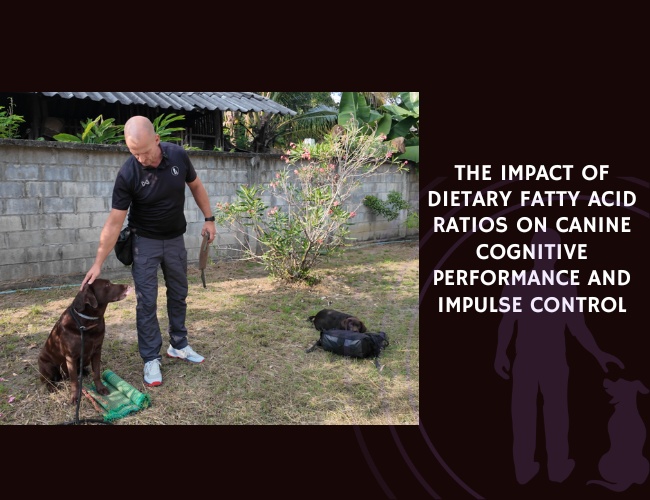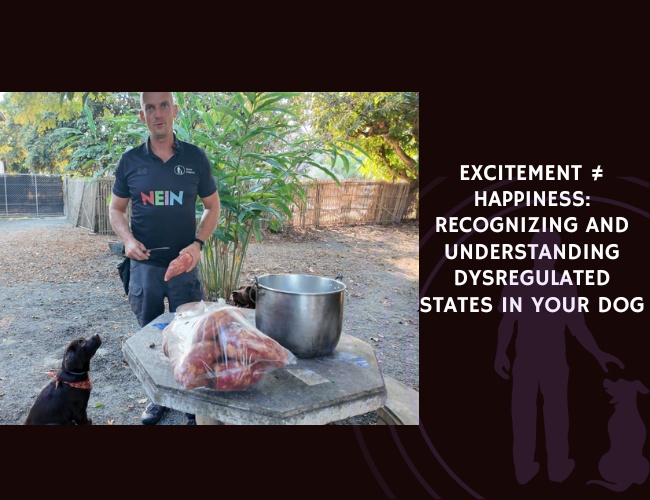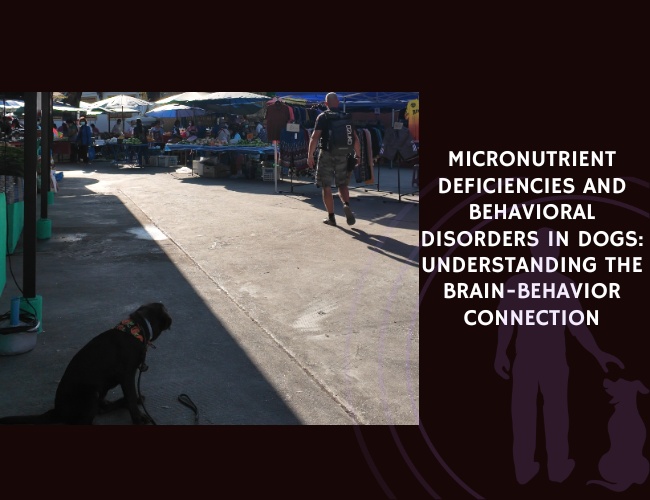Introduction: Understanding Your Dog’s Brain Through Nutrition
Have you ever wondered why some dogs seem sharper, more focused, and better behaved than others? The answer might be sitting right in their food bowl. The emerging science of nutritional neuroscience reveals that the fatty acids in your dog’s diet play a profound role in shaping their cognitive abilities, emotional regulation, and behavioral control. This isn’t just about keeping your furry friend physically healthy—it’s about optimizing their brain function at the molecular level.
For decades, we’ve understood that dogs need certain nutrients to thrive physically. But recent research has unveiled something remarkable: the specific ratio of omega-3 to omega-6 fatty acids in your dog’s diet can fundamentally alter how their brain develops, functions, and ages. These essential fatty acids act as building blocks for neural tissue, messengers for cellular communication, and modulators of inflammation that can either support or hinder cognitive performance.
Let us guide you through this fascinating intersection of nutrition and neuroscience, where every meal becomes an opportunity to enhance your dog’s mental capabilities and emotional wellbeing. Whether you’re raising a puppy whose brain is still developing, maintaining an adult dog’s peak performance, or supporting a senior companion through their golden years, understanding fatty acid nutrition offers powerful tools for optimization. 🧡
The Fundamentals of Fatty Acids in Canine Neurology
Understanding Essential Fatty Acids: The Brain’s Building Blocks
Your dog’s brain is approximately 60% fat by dry weight, making dietary fats far more than just an energy source—they’re structural components of intelligence itself. Essential fatty acids (EFAs) are those that dogs cannot synthesize internally and must obtain through diet. These fall into two primary categories that you’ll want to understand: omega-3 and omega-6 fatty acids.
Omega-3 fatty acids include alpha-linolenic acid (ALA), found in plant sources, and the more bioactive forms EPA (eicosapentaenoic acid) and DHA (docosahexaenoic acid), primarily from marine sources. DHA is particularly crucial—it comprises up to 97% of the omega-3 fatty acids in your dog’s brain and up to 93% of those in the retina. This concentration isn’t arbitrary; DHA integrates into neuronal membranes, affecting their fluidity, flexibility, and ability to transmit signals effectively.
Omega-6 fatty acids, primarily linoleic acid (LA) and arachidonic acid (AA), play equally important but different roles. While necessary for brain function, immune response, and skin health, excessive omega-6 intake—common in many commercial dog foods—can promote inflammatory pathways that interfere with cognitive function. The key isn’t eliminating omega-6 fatty acids but achieving the right balance with omega-3s.
The Molecular Mechanisms: How Fatty Acids Shape Neural Function
Understanding how these fatty acids work at the cellular level helps you appreciate why dietary choices matter so profoundly. When your dog consumes omega-3 fatty acids, they’re incorporated into the phospholipid bilayer of neural cell membranes. This integration affects membrane fluidity, which might sound abstract, but it directly impacts how quickly and efficiently neurons can fire and communicate.
Synaptic plasticity—your dog’s ability to form new neural connections and strengthen existing ones—depends heavily on adequate DHA availability. This fatty acid influences the expression of brain-derived neurotrophic factor (BDNF), often called “miracle grow for the brain.” Higher BDNF levels correlate with improved learning, memory consolidation, and adaptation to new situations. Did you know that dogs with optimal omega-3 levels show measurably faster learning curves in training scenarios?
The anti-inflammatory properties of omega-3s also protect delicate neural tissue from oxidative stress and inflammatory damage. Chronic inflammation in the brain, often driven by excessive omega-6 intake, can manifest as cognitive fog, reduced attention span, and even aggressive behaviors. By modulating inflammatory pathways through dietary fatty acid balance, you’re essentially fine-tuning your dog’s neurological environment for optimal function.
Cognitive Performance: Memory, Learning, and Problem-Solving
The Learning Brain: How Fatty Acids Influence Training Success
Every dog owner wants a pet that learns quickly and retains training effectively. The fatty acid composition of your dog’s diet directly influences their capacity for both. Research from comparative mammalian studies reveals that adequate DHA levels enhance what neuroscientists call “cognitive flexibility”—the ability to adapt thinking and behavior in response to changing circumstances.
When your dog encounters a new command or puzzle toy, their brain must rapidly form new synaptic connections. This process, called long-term potentiation (LTP), requires optimal membrane fluidity and neurotransmitter function—both heavily influenced by omega-3 availability. Dogs fed diets rich in DHA show enhanced performance in spatial memory tasks, faster acquisition of new behaviors, and better retention of learned commands over time.
Working memory, your dog’s ability to hold and manipulate information in real-time, also depends on fatty acid balance. This cognitive function is what allows your dog to remember multi-step commands, navigate complex environments, or track multiple moving objects during play. The prefrontal cortex, which governs working memory, is particularly sensitive to omega-3 deficiency, showing reduced glucose metabolism and neurotransmitter dysfunction when DHA levels drop.
Problem-Solving Abilities and Cognitive Flexibility
You might notice that some dogs seem naturally better at figuring out puzzle feeders or finding creative solutions to challenges. This isn’t just personality—it’s neurobiology influenced by nutrition. Omega-3 fatty acids support the development and function of executive networks in the brain, the same systems that govern planning, reasoning, and problem-solving.
Cognitive flexibility manifests in your dog’s ability to:
- Switch between different tasks or commands without confusion
- Adapt strategies when initial approaches don’t work
- Learn from mistakes and apply lessons to new situations
- Maintain focus despite distractions
Studies examining dietary interventions reveal that dogs supplemented with marine-source omega-3s show significant improvements in cognitive flexibility tests within 8-12 weeks. These improvements aren’t subtle—we’re talking about measurable differences in task completion times, error rates, and adaptive behavior scores.
The mechanism involves enhanced dopaminergic signaling in the frontal cortex. Omega-3 fatty acids influence dopamine receptor sensitivity and turnover, affecting motivation, reward processing, and cognitive control. This explains why dogs with optimal fatty acid intake often appear more engaged, motivated, and persistent when facing challenges. 🐾
Impulse Control and Behavioral Regulation
The Neurobiology of Self-Control in Dogs
Impulse control—your dog’s ability to resist immediate urges in favor of more appropriate behaviors—represents one of the most complex cognitive functions. This capacity depends on the harmonious interaction between the prefrontal cortex (the brain’s CEO) and the limbic system (the emotional center). Fatty acid composition profoundly influences this delicate balance.
When your dog successfully resists lunging at a squirrel or waits patiently for their dinner bowl, they’re demonstrating prefrontal control over limbic impulses. This top-down regulation requires optimal myelination of neural pathways—the fatty insulation that allows signals to travel quickly and efficiently. DHA comprises a significant portion of myelin, and deficiencies can lead to slower neural transmission and weakened impulse control.
The inhibitory control network in your dog’s brain relies on GABAergic neurons—cells that use the neurotransmitter GABA to calm and regulate neural activity. Omega-3 fatty acids enhance GABA receptor function and expression, essentially strengthening your dog’s internal “brake pedal.” Dogs with adequate omega-3 intake show improved performance in impulse control tasks like:
- Waiting before eating when commanded
- Maintaining stays despite distractions
- Resisting the urge to chase or react impulsively
- Demonstrating patience during grooming or veterinary exams
Emotional Regulation and Stress Response
Your dog’s ability to maintain emotional equilibrium in challenging situations directly relates to their fatty acid status. The hypothalamic-pituitary-adrenal (HPA) axis, which governs stress response, is modulated by omega-3 fatty acids through multiple mechanisms. Dogs with optimal omega-3 levels show lower baseline cortisol levels and faster recovery from stressful events.
Amygdala reactivity—how strongly your dog’s fear center responds to potential threats—is dampened by adequate DHA levels. This doesn’t mean your dog becomes less alert or protective; rather, they develop better discrimination between real threats and benign stimuli. The result? Fewer false alarms, less reactive behavior, and improved emotional stability.
Consider how this plays out in daily life: A dog with balanced fatty acid intake might notice the doorbell but remain calm and controlled, while a deficient dog might explode into frantic barking and jumping. This difference isn’t training alone—it’s neurochemistry influenced by diet.
The Omega-3/Omega-6 Ratio: Finding the Sweet Spot
Understanding Optimal Ratios for Canine Health
The absolute amounts of omega-3 and omega-6 fatty acids matter less than their ratio. Modern commercial dog foods often contain omega-6 to omega-3 ratios of 20:1 or even 30:1, far from the evolutionary norm of approximately 5:1 to 10:1 that wild canids would naturally consume. This imbalance has profound implications for your dog’s cognitive and behavioral health.
The inflammatory cascade triggered by excessive omega-6 intake creates a neurological environment hostile to optimal brain function. Arachidonic acid metabolites promote neuroinflammation, which can manifest as:
- Reduced cognitive processing speed
- Impaired memory consolidation
- Increased anxiety and reactivity
- Decreased stress resilience
- Accelerated cognitive aging
Achieving a ratio between 5:1 and 10:1 (omega-6:omega-3) appears optimal for most dogs, though individual needs vary based on age, breed, and health status. This balance supports appropriate inflammatory responses while maintaining the anti-inflammatory protection crucial for brain health.
Practical Strategies for Ratio Optimization
Optimizing your dog’s fatty acid ratio doesn’t require a complete dietary overhaul, but it does demand intentional choices. Start by examining your current dog food’s fatty acid profile—reputable manufacturers provide this information on request if not on the label. Look for foods that explicitly balance omega-3 and omega-6 ratios rather than simply adding fish oil as an afterthought.
Supplementation strategies should focus on marine-source omega-3s, as dogs inefficiently convert plant-based ALA to the more bioactive EPA and DHA. Quality matters enormously—oxidized or rancid fish oils can actually promote inflammation rather than reduce it. Look for:
- Molecularly distilled fish oils free from heavy metals
- Products with added vitamin E to prevent oxidation
- Appropriate dosing based on your dog’s weight (typically 20-50mg EPA+DHA per pound of body weight)
- Regular rotation of sources to prevent nutrient imbalances
Remember that omega-3 supplementation isn’t just about adding more—it’s about achieving balance. If your dog’s base diet is already high in omega-6 fatty acids from chicken, corn, or vegetable oils, you might need higher omega-3 supplementation to achieve optimal ratios.

Neurodevelopment Across Life Stages
Puppy Brain Development: Building the Foundation
The first year of your puppy’s life represents a critical window for brain development, where dietary fatty acids play an outsized role in determining lifelong cognitive capacity. During this period, your puppy’s brain is rapidly myelinating, forming trillions of synaptic connections, and establishing the neural architecture that will support learning and behavior throughout life.
DHA accumulation in the puppy brain peaks during the last trimester of gestation and the first few months after birth. Puppies receiving adequate DHA through their mother’s milk or puppy formula show accelerated cognitive development, including:
- Earlier achievement of developmental milestones
- Enhanced visual acuity and depth perception
- Improved trainability and retention
- Better socialization and reduced fearfulness
- Superior performance on problem-solving tasks
The neuroplasticity of the puppy brain makes it especially responsive to nutritional interventions. Studies show that puppies supplemented with DHA during their first 12 weeks demonstrate significantly higher trainability scores and better performance on cognitive tests even years later. This isn’t surprising when you consider that DHA comprises up to 30% of the fatty acids in the developing brain’s gray matter.
Adult Maintenance: Sustaining Peak Performance
Once your dog reaches adulthood, the focus shifts from building neural infrastructure to maintaining and optimizing existing systems. Adult dogs use omega-3 fatty acids to support ongoing neurogenesis (the birth of new neurons) in the hippocampus, the brain’s memory center. This continued neural renewal is essential for maintaining learning capacity and adapting to new experiences.
Working and performance dogs have particularly high demands for optimal fatty acid nutrition. Whether your dog competes in agility, serves as a therapy animal, or works in detection, their cognitive demands require premium neural support. These dogs benefit from:
- Higher baseline omega-3 intake to support intense cognitive activity
- Strategic supplementation before competitions or demanding tasks
- Careful monitoring of inflammatory markers that might indicate imbalance
- Regular cognitive enrichment paired with nutritional support
The adult brain’s fatty acid requirements also fluctuate with stress, illness, and environmental challenges. During periods of increased cognitive demand or stress, your dog’s omega-3 needs may temporarily increase. Being attuned to these variations allows you to adjust supplementation accordingly.
Senior Cognitive Support: Protecting the Aging Brain
As your dog enters their senior years, fatty acid nutrition becomes even more critical for maintaining cognitive function and potentially slowing age-related decline. The aging canine brain faces multiple challenges: oxidative stress, chronic low-grade inflammation, reduced neuroplasticity, and accumulation of metabolic waste products. Omega-3 fatty acids address each of these concerns through distinct mechanisms.
Cognitive dysfunction syndrome (CDS), the canine equivalent of dementia, affects a significant percentage of senior dogs. Research indicates that dogs maintained on high-DHA diets throughout life show delayed onset and reduced severity of CDS symptoms. Even when supplementation begins in senior years, improvements in:
- Spatial navigation and memory
- Recognition of family members
- Sleep-wake cycle regulation
- House-training retention
- General alertness and engagement
The neuroprotective effects of omega-3s in senior dogs extend beyond simple anti-inflammation. DHA supports the clearance of amyloid-beta proteins, maintains blood-brain barrier integrity, and promotes the survival of existing neurons despite age-related stressors. This multi-faceted protection can mean the difference between a senior dog who remains engaged and trainable versus one who becomes confused and withdrawn. 🧡
Clinical Applications and Behavioral Interventions
Addressing Anxiety and Stress-Related Behaviors
Anxiety disorders in dogs represent one of the most common behavioral challenges, affecting up to 70% of dogs in some form. While training and environmental management remain crucial, nutritional intervention through fatty acid optimization offers a complementary approach that addresses the neurobiological roots of anxiety.
Dogs with anxiety often show dysregulation in their serotonergic and GABAergic systems—the same neurotransmitter networks targeted by anti-anxiety medications. Omega-3 fatty acids, particularly EPA, influence these systems naturally by:
- Enhancing serotonin receptor sensitivity
- Promoting GABA production and receptor function
- Reducing inflammatory cytokines that exacerbate anxiety
- Supporting healthy cortisol rhythms
Separation anxiety, one of the most challenging conditions for both dogs and owners, shows particular responsiveness to omega-3 intervention. Dogs supplemented with therapeutic doses of EPA and DHA demonstrate reduced vocalization, destructive behavior, and physiological stress markers when left alone. The mechanism appears to involve enhanced prefrontal regulation of the amygdala’s fear response.
You might notice changes within 6-8 weeks of beginning supplementation: your anxious dog becomes more settled, shows improved focus during training, and recovers more quickly from stressful events. These aren’t placebo effects—they’re measurable neurobiological changes reflected in behavior.
Managing Hyperactivity and Attention Deficits
Some dogs seem to vibrate with excess energy, struggling to focus, settle, or engage in calm behaviors. While breed and temperament play roles, nutritional factors—particularly fatty acid imbalance—can exacerbate these tendencies. The parallels between canine hyperactivity and human ADHD are striking, and both conditions show similar responses to omega-3 intervention.
Hyperactive dogs often display:
- Inability to settle even when tired
- Excessive jumping, mouthing, or demand behaviors
- Poor impulse control around triggers
- Difficulty maintaining focus during training
- Rapid switching between activities without completion
The neurological underpinnings of hyperactivity involve dopaminergic dysfunction, reduced prefrontal control, and often, chronic low-grade inflammation affecting neural function. Omega-3 supplementation addresses these issues by enhancing dopamine receptor function, supporting prefrontal development, and reducing neuroinflammation.
Clinical trials in hyperactive dogs show that omega-3 supplementation can reduce activity levels by 20-30% while improving focus and trainability scores. These improvements occur gradually, typically becoming noticeable after 8-12 weeks of consistent supplementation. The key is maintaining therapeutic doses—suboptimal supplementation may show little effect.
Supporting Dogs with Cognitive Dysfunction
Canine Cognitive Dysfunction Syndrome represents a heartbreaking decline that affects many senior dogs. However, emerging evidence suggests that strategic fatty acid intervention can slow progression and even temporarily reverse some symptoms. This isn’t false hope—it’s based on understanding how omega-3s support failing neural systems.
The CDS brain shows several pathological changes:
- Accumulation of amyloid plaques
- Reduced cerebral blood flow
- Mitochondrial dysfunction
- Chronic neuroinflammation
- Loss of synaptic connections
DHA supplementation addresses multiple aspects of this pathology simultaneously. It enhances cerebral blood flow through vasodilation, supports mitochondrial membrane integrity, reduces inflammatory mediator production, and promotes the expression of neuroprotective factors. Some dogs show remarkable improvement within weeks of beginning therapeutic supplementation.
Treatment protocols for CDS typically involve higher doses than preventive supplementation—often 50-100mg of combined EPA+DHA per pound of body weight. This aggressive approach, combined with cognitive enrichment and appropriate medical management, can extend quality cognitive life by months or even years.
Balanced. Vital. Transformative.
Fat fuels cognition. With the brain composed largely of fat, the balance of omega-3 and omega-6 fatty acids determines how efficiently neurons fire, connect, and adapt. This molecular foundation shapes memory, focus, and impulse control at the deepest level.
Ratios refine behavior. Too much omega-6 sparks inflammation that clouds cognition, while adequate omega-3, especially DHA, enhances neural plasticity and emotional regulation. The right balance doesn’t just prevent decline—it actively sharpens mental clarity.



Nutrition drives learning. Dogs fed diets rich in DHA show faster adaptation, stronger retention, and greater problem-solving ability. Each meal becomes a tool for building resilience, teaching focus, and sustaining a lifetime of cognitive strength.
Practical Implementation: From Theory to Bowl
Selecting High-Quality Fatty Acid Sources
Not all omega-3 sources are created equal, and understanding quality markers helps you make informed choices for your dog. Marine sources—particularly small, cold-water fish like sardines, anchovies, and krill—provide the most bioavailable forms of EPA and DHA. These sources also tend to have lower contamination levels due to their position in the food chain.
Quality indicators to look for include:
- Third-party testing for heavy metals and oxidation
- Sustainable sourcing certifications
- Proper storage and handling (refrigeration)
- Added antioxidants for stability
- Clear labeling of EPA and DHA content
- Appropriate concentration for therapeutic dosing
Plant-based omega-3 sources like flaxseed, chia, and hemp provide ALA, which dogs convert inefficiently to EPA and DHA (less than 10% conversion rate). While these sources offer other nutritional benefits, they shouldn’t be relied upon as primary omega-3 sources for cognitive support.
Consider rotating between different omega-3 sources to provide a broader nutrient profile and reduce the risk of developing sensitivities. Some dogs respond better to krill oil due to its phospholipid-bound omega-3s, while others thrive on high-quality fish oil. Monitoring your dog’s response helps identify the optimal source.
Dosing Strategies and Bioavailability Optimization
Determining the right omega-3 dose for your dog requires considering multiple factors: weight, age, current health status, baseline diet, and specific goals (prevention vs. treatment). General maintenance doses range from 20-30mg of combined EPA+DHA per pound of body weight, while therapeutic doses for behavioral or cognitive issues may reach 50-100mg per pound.
Bioavailability enhancement strategies maximize the benefit from supplementation:
- Administer with meals containing some fat for better absorption
- Divide daily doses into two servings for sustained levels
- Consider phospholipid-bound forms for enhanced brain uptake
- Pair with vitamin E to prevent oxidation and support utilization
- Maintain consistent timing for optimal circadian integration
Start supplementation gradually, beginning with 25% of the target dose and increasing over two weeks. This approach minimizes digestive upset and allows you to monitor for any adverse reactions. Some dogs experience loose stools initially, which typically resolves as the body adjusts.
Monitoring Response and Adjusting Protocols
Assessing your dog’s response to fatty acid supplementation requires patience and systematic observation. Unlike medications that might show immediate effects, nutritional interventions work gradually at the cellular level. Create a behavior diary noting changes in:
- Learning speed and retention
- Emotional regulation and stress recovery
- Activity levels and settling ability
- Social interactions and confidence
- Sleep quality and patterns
- Appetite and food motivation
Objective measures can supplement your observations:
- Training performance metrics (repetitions to mastery)
- Timed problem-solving tasks
- Veterinary cognitive assessment scores
- Inflammatory marker testing (in consultation with your vet)
- Video documentation of behavior changes
Most dogs show initial improvements within 4-6 weeks, with continued gains over 3-6 months. If you don’t observe changes after 12 weeks at therapeutic doses, consider factors like absorption issues, concurrent health problems, or the need for additional interventions beyond nutrition alone.
Interactions with Other Nutrients and Medications
Synergistic Nutrients for Cognitive Enhancement
Omega-3 fatty acids don’t work in isolation—they interact with numerous other nutrients to support cognitive function. Understanding these interactions helps you create a comprehensive nutritional strategy that maximizes brain health benefits.
B-complex vitamins play crucial roles in fatty acid metabolism and neurotransmitter synthesis. Vitamins B6, B12, and folate support the methylation processes necessary for incorporating omega-3s into neural membranes. Dogs deficient in B vitamins may not fully utilize supplemented omega-3s, limiting cognitive benefits. Ensure your dog’s diet provides adequate B vitamins or consider a high-quality multivitamin.
Antioxidants like vitamins E and C, selenium, and carotenoids protect omega-3 fatty acids from oxidation while supporting their anti-inflammatory effects. Vitamin E is particularly important—it prevents omega-3 degradation in storage and in the body while supporting neural membrane integrity. The ideal ratio appears to be approximately 1 IU of vitamin E per gram of fish oil.
Medium-chain triglycerides (MCTs) from coconut oil provide an alternative brain fuel that can enhance the cognitive benefits of omega-3s, particularly in senior dogs. MCTs bypass normal fat metabolism, providing quick energy to brain cells that may struggle with glucose utilization. The combination of omega-3s and MCTs shows synergistic effects in supporting cognitive function in aging dogs.
Medication Interactions and Considerations
If your dog takes medications, understanding potential interactions with omega-3 supplementation is essential. While generally safe, high-dose omega-3s can influence drug metabolism and effectiveness in several ways.
Anticoagulant medications like aspirin or prescription blood thinners may interact with high-dose omega-3s, which have mild antiplatelet effects. This doesn’t necessarily contraindicate supplementation but may require dose adjustment or closer monitoring. Always inform your veterinarian about omega-3 supplementation if your dog requires surgery or takes anticoagulants.
NSAIDs (non-steroidal anti-inflammatory drugs) often prescribed for arthritis may have enhanced effects when combined with omega-3s. This can be beneficial, potentially allowing for lower medication doses, but requires veterinary oversight to prevent over-suppression of necessary inflammatory responses.
Behavioral medications like fluoxetine or clomipramine for anxiety may show enhanced efficacy when combined with omega-3 supplementation. The mechanisms appear complementary—medications target specific neurotransmitter systems while omega-3s provide broader neural support. Some dogs successfully reduce or eliminate medication needs after establishing optimal omega-3 status, though this should only be done under veterinary guidance.

Breed-Specific Considerations and Genetic Factors
High-Energy and Working Breeds: Special Requirements
Border Collies, German Shepherds, Belgian Malinois, and other high-drive working breeds have intense cognitive demands that translate to higher fatty acid requirements. These dogs’ brains are essentially high-performance engines requiring premium fuel for optimal function.
Working breed characteristics that increase omega-3 needs:
- Intense focus and sustained attention during work
- Rapid information processing and decision-making
- High stress tolerance and recovery demands
- Extended training sessions requiring neural plasticity
- Greater susceptibility to anxiety when under-stimulated
These breeds often benefit from baseline supplementation 25-50% higher than average recommendations. During periods of intense training or competition, temporary increases may support performance and recovery. Monitor for signs of cognitive fatigue: decreased focus, irritability, or slow learning may indicate insufficient omega-3 support.
The genetic selection for high drive and trainability in these breeds appears linked to enhanced dopaminergic activity, which requires adequate omega-3s for optimal function. This may explain why working breeds often show dramatic behavioral improvements with proper supplementation—their high-powered neural systems are particularly sensitive to nutritional support or deficiency.
Brachycephalic Breeds and Neurological Sensitivities
Flat-faced breeds like Bulldogs, Pugs, and French Bulldogs face unique neurological challenges that fatty acid optimization can help address. The same genetic modifications that create their characteristic appearance can affect brain development and function.
Brachycephalic considerations include:
- Higher risk of hypoxic events affecting brain function
- Increased susceptibility to heat stress and inflammation
- Potential for hydrocephalus and other structural issues
- Greater prevalence of anxiety and compulsive behaviors
- Sleep disruption from breathing difficulties affecting cognition
These breeds may particularly benefit from omega-3’s neuroprotective and anti-inflammatory effects. The improved cerebral blood flow supported by DHA can partially compensate for intermittent hypoxia, while anti-inflammatory effects may reduce brain swelling risk. Start supplementation early in brachycephalic puppies to support optimal neural development despite structural challenges.
Giant Breeds: Supporting the Developing Brain
Large and giant breeds face unique developmental challenges, with rapid growth potentially outpacing nutritional support for optimal brain development. Great Danes, Mastiffs, Saint Bernards, and similar breeds require careful attention to fatty acid nutrition during their extended growth period.
The prolonged development period in giant breeds—often up to 24 months—means an extended window for nutritional intervention. However, it also means greater vulnerability to deficiencies during critical developmental stages. These breeds benefit from:
- Consistent omega-3 supplementation throughout growth
- Careful ratio balance to prevent excessive inflammation during rapid development
- Higher absolute doses due to body size, but careful not to over-supplement
- Special attention during adolescence when cognitive maturation accelerates
Giant breeds also face earlier cognitive aging, making lifelong fatty acid optimization particularly important. Starting preventive supplementation in young adulthood may delay age-related cognitive decline that can begin as early as 5-6 years in these breeds.
Future Directions and Emerging Research
Nutrigenomics: Personalized Fatty Acid Nutrition
The emerging field of nutrigenomics promises to revolutionize how we approach canine nutrition by considering individual genetic variations that affect nutrient metabolism. Just as some humans have genetic variants affecting omega-3 metabolism, similar variations likely exist in dogs, potentially explaining why some individuals show dramatic responses to supplementation while others show modest changes.
Current research is identifying genetic markers associated with:
- Fatty acid desaturase enzyme efficiency
- Transport protein expression
- Inflammatory response patterns
- Neurotransmitter synthesis pathways
- Oxidative stress susceptibility
In the near future, genetic testing might guide personalized supplementation protocols, identifying dogs who need higher doses, specific fatty acid ratios, or complementary nutrients for optimal cognitive benefit. This precision approach could maximize benefits while minimizing unnecessary supplementation.
Early studies suggest breed-specific patterns in fatty acid metabolism genes, which aligns with observed breed differences in supplement response. As this research progresses, we might see breed-specific supplementation guidelines replacing current one-size-fits-all approaches.
Novel Delivery Systems and Bioavailability Enhancement
Researchers are developing innovative delivery systems to enhance omega-3 bioavailability and targeting to the brain. These advances could dramatically improve the efficacy of supplementation while reducing required doses.
Emerging technologies include:
- Nanoencapsulation for enhanced absorption and stability
- Phospholipid complexes that mimic natural transport systems
- Time-release formulations for sustained blood levels
- Targeted delivery systems that preferentially accumulate in neural tissue
- Combination products that package omega-3s with synergistic nutrients
Some of these technologies show 3-5 times greater bioavailability than traditional fish oil supplements. As they become commercially available, they may allow for lower supplementation doses with superior cognitive benefits, reducing concerns about excessive supplementation or digestive upset.
Expanding Understanding of Cognitive Biomarkers
The development of objective biomarkers for canine cognitive function will allow more precise assessment of fatty acid intervention effects. Current research is validating various measures that could become standard tools for monitoring cognitive health and supplement response.
Promising biomarkers under investigation:
- Serum BDNF levels as indicators of neuroplasticity
- Inflammatory cytokine profiles reflecting brain health
- Cortisol rhythm patterns indicating stress regulation
- Heart rate variability showing autonomic balance
- Novel behavioral assessment batteries detecting subtle cognitive changes
These objective measures will complement behavioral observations, allowing earlier detection of cognitive decline and more precise supplementation adjustments. They may also identify dogs at higher risk for cognitive dysfunction, enabling preventive intervention before symptoms appear.
Conclusion: Empowering Your Dog’s Cognitive Potential
The journey through the science of fatty acids and canine cognition reveals a powerful truth: you have more control over your dog’s mental capabilities and emotional wellbeing than you might have imagined. Every meal, every supplement, every nutritional choice contributes to the intricate neural symphony playing out in your dog’s brain. Understanding this connection transforms feeding from a routine task into an opportunity for cognitive enhancement.
The evidence is clear and compelling. Optimal omega-3 to omega-6 ratios support every aspect of cognitive function, from the rapid neural development of puppyhood through the preservation of mental acuity in senior years. Whether you’re addressing specific behavioral challenges, supporting a working dog’s peak performance, or simply ensuring your companion’s best possible quality of life, fatty acid optimization offers a scientifically validated path forward.
Key takeaways to remember:
- The ideal omega-6 to omega-3 ratio ranges from 5:1 to 10:1
- Marine-source omega-3s (EPA and DHA) are most effective for cognitive support
- Supplementation effects appear gradually, typically over 6-12 weeks
- Individual needs vary based on age, breed, and health status
- Quality matters as much as quantity in fatty acid supplementation
As research continues to unveil the intricate relationships between nutrition and neurology, one thing becomes increasingly clear: supporting your dog’s cognitive health through optimal fatty acid nutrition isn’t just about preventing problems—it’s about unlocking potential. The same nutritional strategies that enhance learning and training success also support emotional stability, stress resilience, and the maintenance of cognitive function throughout life.
Your next steps are clear. Evaluate your dog’s current diet, considering both the base food and any supplements. Look for quality omega-3 sources that provide therapeutic levels of EPA and DHA. Monitor your dog’s response systematically, noting improvements in learning, behavior, and overall engagement with life. Work with your veterinarian to integrate nutritional strategies with any other interventions your dog may need.
Remember, you’re not just feeding your dog—you’re nourishing their remarkable brain, supporting the neural networks that make them the intelligent, adaptable, loving companions we cherish. In this light, that daily bowl of food becomes something more: a foundation for cognitive vitality, a buffer against age-related decline, and a key to unlocking your dog’s full mental and emotional potential. The science is here, the tools are available, and your dog’s enhanced cognitive future awaits. 🐾










